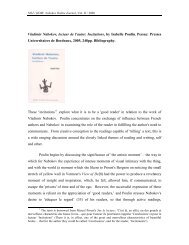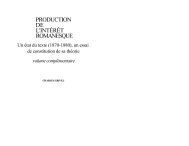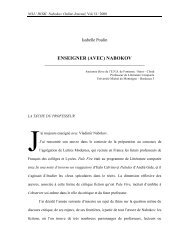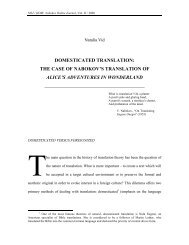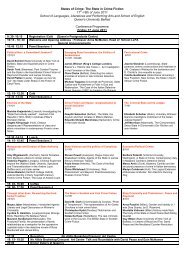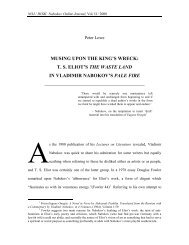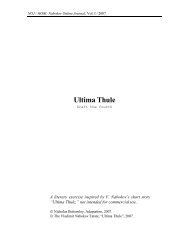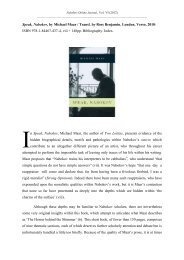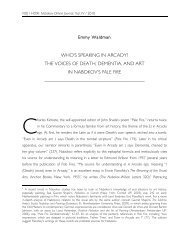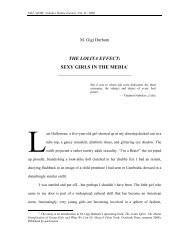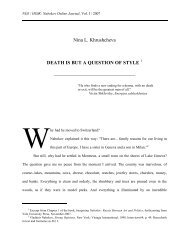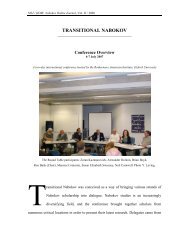through the looking-glass – pale fire as anamorphosis
through the looking-glass – pale fire as anamorphosis
through the looking-glass – pale fire as anamorphosis
You also want an ePaper? Increase the reach of your titles
YUMPU automatically turns print PDFs into web optimized ePapers that Google loves.
Nabokov Online Journal, Vol. VI (2012)<br />
_______________________________________________________________________<br />
<strong>the</strong> argument <strong>–</strong> is <strong>the</strong> poor quality of <strong>the</strong> variants Kinbote invents. I do not find this entirely<br />
convincing, because it seems to me that critics here trust Kinbote ra<strong>the</strong>r more than objectivity<br />
warrants. If we agree that Pale Fire’s commentator is a m<strong>as</strong>ter in <strong>the</strong> art of manipulation and<br />
<strong>the</strong> epitome of <strong>the</strong> unreliable narrator (and most critics concur with this), <strong>the</strong>n why should we<br />
suddenly start believing him when he claims that he cannot write verse? It might e<strong>as</strong>ily be a<br />
feint. As for <strong>the</strong> poor quality of his variants, someone with such talent for deceit is certainly<br />
capable of fabricating bad verse on purpose (which, incidentally, would recall ano<strong>the</strong>r of<br />
Nabokov’s characters, V<strong>as</strong>iliy Shishkov 10 ). And surely, if Kinbote had written <strong>the</strong> poem but<br />
wanted us to believe o<strong>the</strong>rwise, he would know better than “blowing his cover,” <strong>as</strong> <strong>the</strong>y say in<br />
spy novels, by producing high-quality variants. Therefore, Kinbote’s claim that he is a poor<br />
rhymester and <strong>the</strong> bad variants do not prove that he did not write <strong>the</strong> poem. At best, <strong>the</strong>se two<br />
elements taken toge<strong>the</strong>r prove that he wants us to believe that he could not write it. B. Boyd<br />
puts forward three o<strong>the</strong>r arguments to refute <strong>the</strong> Kinbotean hypo<strong>the</strong>sis, regarding “interest in<br />
o<strong>the</strong>rs,” “discipline” and “motive.” Although I will not go into a specific discussion of <strong>the</strong>se<br />
arguments here, <strong>the</strong>y seem to me equally debatable, essentially because <strong>the</strong>y rest on <strong>the</strong> sort<br />
of reading of <strong>the</strong> Foreword and <strong>the</strong> Commentary that Kinbote wants us to adopt. In o<strong>the</strong>r<br />
words, <strong>the</strong>y play by his rules, and into his hands. The refutations of <strong>the</strong> Shadean line, and <strong>the</strong><br />
postulates of <strong>the</strong> “ghost <strong>the</strong>ory” would also be interesting to examine: although brilliant at<br />
times, <strong>the</strong>y are questionable here and <strong>the</strong>re <strong>as</strong> well, but I will leave it at that for now.<br />
My aim in this study is to suggest that, although a great deal h<strong>as</strong> been said, all avenues<br />
have not been explored on <strong>the</strong> question of authorship in Pale Fire. It seems that so far, critics<br />
trying to account for <strong>the</strong> web of coincidences between Shade’s world and Kinbote’s Zembla,<br />
and going for a sole authorship approach, have only considered ei<strong>the</strong>r Shade or Kinbote <strong>as</strong><br />
possible alternatives. 11 I would like to put forward a reading of <strong>the</strong> novel that departs from<br />
previous interpretations in that it posits that <strong>the</strong> author of <strong>the</strong> poem and <strong>the</strong> Commentary is<br />
nei<strong>the</strong>r of <strong>the</strong>se two characters. I will start with <strong>the</strong> examination of what appears <strong>as</strong> an<br />
important <strong>the</strong>me in <strong>the</strong> novel although it h<strong>as</strong>, I think, seldom been delved into. I will <strong>the</strong>n try<br />
to show that this <strong>the</strong>me leads us to uncover what appears <strong>as</strong> a major pictorial subtext of Pale<br />
Fire: Hans Holbein’s The Amb<strong>as</strong>sadors. This subtext, closely connected to <strong>the</strong> use of one<br />
10 V. Nabokov, “V<strong>as</strong>iliy Shishkov,” The Stories of Vladimir Nabokov, New York: Knopf, 1995, 490-495.<br />
11 In all fairness, Don Barton Johnson did suggest that <strong>the</strong> real author of Pale Fire might be V. Botkin (Worlds in<br />
Regression: Some Novels of Vladimir Nabokov, Ann Arbor: Ardis, 1985, 60-77) and B. Boyd calls him a “semi-<br />
Botkinian” (“Shade and Shape in Pale Fire,” note 5). Yet <strong>the</strong> admission that Botkin and Kinbote are probably<br />
<strong>the</strong> same person makes this interpretation “semi-Kinbotean” <strong>as</strong> well.<br />
3



